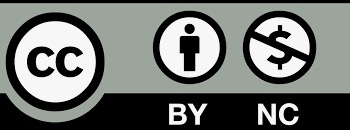Published
2025-02-14
Section
Research Articles
License
The journal adopts the Attribution-NonCommercial 4.0 International (CC BY-NC 4.0), which means that anyone can reuse and redistribute the materials for non-commercial purposes as long as you follow the license terms and the original source is properly cited.
Author(s) shall retain the copyright of their work and grant the Journal/Publisher rights for the first publication with the work concurrently licensed since 2023 Vol.8 No.2.
Under this license, author(s) will allow third parties to download, reuse, reprint, modify, distribute and/or copy the content under the condition that the authors are given credit. No permission is required from the authors or the publisher.
This broad license intends to facilitate free access, as well as the unrestricted use of original works of all types. This ensures that the published work is freely and openly available in perpetuity.
By providing open access, the following benefits are brought about:
- Higher Visibility, Availability and Citations-free and unlimited accessibility of the publication over the internet without any restrictions increases citation of the article.
- Ease of search-publications are easily searchable in search engines and indexing databases.
- Rapid Publication – accepted papers are immediately published online.
- Available for free download immediately after publication at https://esp.as-pub.com/index.php/ESP

Copyright Statement
1.The authors certify that the submitted manuscripts are original works, do not infringe the rights of others, are free from academic misconduct and confidentiality issues, and that there are no disputes over the authorship scheme of the collaborative articles. In case of infringement, academic misconduct and confidentiality issues, as well as disputes over the authorship scheme, all responsibilities will be borne by the authors.
2. The author agrees to grant the Editorial Office of Environment and Social Psychology a licence to use the reproduction right, distribution right, information network dissemination right, performance right, translation right, and compilation right of the submitted manuscript, including the work as a whole, as well as the diagrams, tables, abstracts, and any other parts that can be extracted from the work and used in accordance with the characteristics of the journal. The Editorial Board of Environment and Social Psychology has the right to use and sub-licence the above mentioned works for wide dissemination in print, electronic and online versions, and, in accordance with the characteristics of the periodical, for the period of legal protection of the property right of the copyright in the work, and for the territorial scope of the work throughout the world.
3. The authors are entitled to the copyright of their works under the relevant laws of Singapore, provided that they do not exercise their rights in a manner prejudicial to the interests of the Journal.
About Licence
Environment and Social Psychology is an open access journal and all published work is available under the Creative Commons Licence, Authors shall retain copyright of their work and grant the journal/publisher the right of first publication, and their work shall be licensed under the Attribution-NonCommercial 4.0 International (CC BY-NC 4.0).
Under this licence, the author grants permission to third parties to download, reuse, reprint, modify, distribute and/or copy the content with attribution to the author. No permission from the author or publisher is required.
This broad licence is intended to facilitate free access to and unrestricted use of original works of all kinds. This ensures that published works remain free and accessible in perpetuity. Submitted manuscripts, once accepted, are immediately available to the public and permanently accessible free of charge on the journal’s official website (https://esp.as-pub.com/index.php/ESP). Allowing users to read, download, copy, print, search for or link to the full text of the article, or use it for other legal purposes. However, the use of the work must retain the author's signature, be limited to non-commercial purposes, and not be interpretative.
Click to download <Agreement on the Licence for the Use of Copyright on Environmental and Social Psychology>.
How to Cite
Applying the theory of planned behavior to predict the sustainable logistics practice of small and medium-sized enterprises
Yunjia Li
Department of International Trade, Hainan College of Economics and Business, Haikou, 571127, China
Qi Ding
Department of International Trade, Hainan College of Economics and Business, Haikou, 571127, China
DOI: https://doi.org/10.59429/esp.v10i1.3100
Keywords: sustainable logistics, small and medium-sized enterprises (SMEs), theory of planned behavior, adoption intention, structural equation modeling, firm size, industry type, supply chain management
Abstract
This study investigates the factors influencing sustainable logistics practices among small and medium-sized enterprises (SMEs) using an extended Theory of Planned Behavior (TPB) framework. A mixed-methods approach, including a large-scale survey and semi-structured interviews, was employed to collect data from SME managers across various industries. Structural equation modeling revealed that attitudes, subjective norms, and perceived behavioral control significantly influence SMEs' intentions to adopt sustainable logistics practices, with these intentions strongly predicting actual behavior. Adoption intention fully mediates the effects of attitude and subjective norms on sustainable logistics behavior, while partially mediating the effect of perceived behavioral control. Firm size and industry type moderate these relationships, highlighting the importance of contextual factors. The findings offer valuable insights for policymakers and practitioners, suggesting that initiatives focused on improving attitudes, strengthening industry norms, and enhancing perceived control may effectively promote sustainable logistics practices among SMEs. Future research should explore longitudinal effects and additional contextual factors to further understand the dynamics of sustainability adoption in the SME sector.
References
[1]. Aarikka-Stenroos, L., Chiaroni, D., Kaipainen, J., & Urbinati, A. (2022). Companies' circular business models enabled by supply chain collaborations: An empirical-based framework, synthesis, and research agenda. Industrial Marketing Management, 105, 322–339.
[2]. Ageron, B., Gunasekaran, A., & Spalanzani, A. (2012). Sustainable supply management: An empirical study. International Journal of Production Economics, 140, 168–182.
[3]. Akamp, M., & Müller, M. (2013). Supplier management in developing countries. Journal of Cleaner Production, 56, 54–62.
[4]. Andalib Ardakani, D., & Soltanmohammadi, A. (2019). Investigating and analysing the factors affecting the development of sustainable supply chain model in the industrial sectors. Corporate Social Responsibility and Environmental Management, 26(1), 199–212.
[5]. Blome, C., Hollos, D., & Paulraj, A. (2014). Green procurement and green supplier development: Antecedents and effects on supplier performance. International Journal of Production Research, 52(1), 32–49.
[6]. Bocken, N. M., & Geradts, T. H. (2020). Barriers and drivers to sustainable business model innovation: Organization design and dynamic capabilities. Long Range Planning, 53(4), 101950.
[7]. Bocken, N. M. P., Short, S. W., Rana, P., & Evans, S. (2014). A literature and practice review to develop sustainable business model archetypes. Journal of Cleaner Production, 65, 42–56.
[8]. Boons, F., & Lüdeke-Freund, F. (2013). Business models for sustainable innovation: State-of-the-art and steps towards a research agenda. Journal of Cleaner Production, 45, 9–19.
[9]. Brandenburg, M., Govindan, K., Sarkis, J., & Seuring, S. (2014). Quantitative models for sustainable supply chain management: Developments and directions. European Journal of Operational Research, 233(2), 299–312.
[10]. Cantele, S., & Zardini, A. (2020). What drives small and medium enterprises towards sustainability? Role of interactions between pressures, barriers, and benefits. Corporate Social Responsibility and Environmental Management, 27(1), 126–136.
[11]. Chauhan, C., Kaur, P., Arrawatia, R., Ractham, P., & Dhir, A. (2022). Supply chain collaboration and sustainable development goals (SDGs). Teamwork makes achieving SDGs dream work. Journal of Business Research, 147, 290–307.
[12]. Chen, L., Zhao, X., Tang, O., Price, L., Zhang, S., & Zhu, W. (2017). Supply chain collaboration for sustainability: A literature review and future research agenda. International Journal of Production Economics, 194, 73–87.
[13]. Da Giau, A., Lion, A., Macchion, L., Caridi, M., Caniato, F., Cappellari, R., Danese, P., Rinaldi, R., & Vinelli, A. (2016). The challenge of sustainability within the Italian fashion system. In A. Vecchi & C. Buckley (Eds.), Handbook of research on global fashion management and merchandising. IGI Global.
[14]. Elkington, J. (1997). The triple bottom line. Environmental Management: Readings and Cases, 2, 49–66.
[15]. Ellen MacArthur Foundation. (2018). https://www.ellenmacarthurfoundation.org/
[16]. Evans, D., Vladimirova, M., van Holgado, K., Fossen, M., Yang, E., & Silva, C. B. (2017). Business model innovation for sustainability: Towards a unified perspective for creation of sustainable business models. Business Strategy and the Environment, 26, 597–608.
[17]. Farooque, M., Zhang, A., Thürer, M., Qu, T., & Huisingh, D. (2019). Circular supply chain management: A definition and structured literature review. Journal of Cleaner Production, 228, 882–900.
[18]. Feng, T., Jiang, Y., & Xu, D. (2020). The dual-process between green supplier collaboration and firm performance: A behavioral perspective. Journal of Cleaner Production, 260, 121073.
[19]. Geissdoerfer, M., Vladimirova, D., & Evans, S. (2018). Sustainable business model innovation: A review. Journal of Cleaner Production, 198, 401–416.
[20]. Gimenez, C., & Sierra, V. (2013). Sustainable supply chains: Governance mechanisms to greening suppliers. Journal of Business Ethics, 116(1), 189–203.
[21]. Gimenez, C., & Tachizawa, E. M. (2012). Extending sustainability to suppliers: A systematic literature review. Supply Chain Management: An International Journal, 17, 531–543.
[22]. Gold, S., Seuring, S., & Beske, P. (2010). Sustainable supply chain management and inter-organizational resources: A literature review. Corporate Social Responsibility and Environmental Management, 17(4), 230–245.
[23]. Harris, H. (2001). Content analysis of secondary data: A study of courage in managerial decision making. Journal of Business Ethics, 34, 191–208.
[24]. Hou, T. C. T. (2019). The relationship between corporate social responsibility and sustainable financial performance: Firm-level evidence from Taiwan. Corporate Social Responsibility and Environmental Management, 26(1), 19–28.
[25]. Khan, S. A., Mubarik, M. S., Kusi-Sarpong, S., Zaman, S. I., & Kazmi, S. H. A. (2021). Social sustainable supply chains in the food industry: A perspective of an emerging economy. Corporate Social Responsibility and Environmental Management, 28(1), 404–418.
[26]. Krause, D. R., Vachon, S., & Klassen, R. D. (2009). Special topic forum on sustainable supply chain management: Introduction and reflections on the role of purchasing management. Journal of Supply Chain Management, 45(4), 18–25.
[27]. Macchion, L., Moretto, A., Caniato, F., Danese, P., & Vinelli, A. (2020). Static supply chain complexity and sustainability practices: A multitier examination. Corporate Social Responsibility and Environmental Management, 27(6), 2679–2691.
[28]. Moretto, A., Macchion, L., Lion, A., Caniato, F., Danese, P., & Vinelli, A. (2018). Designing a roadmap towards a sustainable supply chain: A focus on the fashion industry. Journal of Cleaner Production, 193, 169–184.
[29]. Muñoz-Torres, M. J., Fernández-Izquierdo, M. A., Rivera-Lirio, J. M., & Escrig-Olmedo, E. (2019). Can environmental, social, and governance rating agencies favor business models that promote a more sustainable development? Corporate Social Responsibility and Environmental Management, 26(2), 439–452.
[30]. Nielsen. (2015). http://www.nielsen.com/us/en/insights/reports/2015/the-sustainability-imperative.html
[31]. Nudurupati, S. S., Budhwar, P., Pappu, R. P., Chowdhury, S., Kondala, M., Chakraborty, A., & Ghosh, S. K. (2022). Transforming sustainability of Indian small and medium-sized enterprises through circular economy adoption. Journal of Business Research, 149, 250–269.
[32]. Osterwalder, A., Pigneur, Y., & Tucci, C. L. (2005). Clarifying business models: Origins, present, and future of the concept. Communications of the Association for Information Systems, 16(1), 1.
[33]. Pedersen, E. (2009). The many and the few: Rounding up the SMEs that manage CSR in the supply chain. Supply Chain Management: An International Journal, 14(2), 109–116.
[34]. Pedersen, E. R. G., Gwozdz, W., & Hvass, K. K. (2016). Exploring the relationship between business model innovation, corporate sustainability, and organisational values within the fashion industry. Journal of Business Ethics, 149, 1–18.
[35]. Peralta, A., Carrillo-Hermosilla, J., & Crecente, F. (2019). Sustainable business model innovation and acceptance of its practices among Spanish entrepreneurs. Corporate Social Responsibility and Environmental Management, 26(5), 1119–1134.
[36]. Reefke, H., & Sundaram, D. (2017). Key themes and research opportunities in sustainable supply chain management–identification and evaluation. Omega, 66, 195–211.
[37]. Sarkis, J. (2012). A boundaries and flows perspective of green supply chain management. Supply Chain Management. An International Journal, 17(2), 202–216.
[38]. Scarpellini, S. (2022). Social impacts of a circular business model: An approach from a sustainability accounting and reporting perspective. Corporate Social Responsibility and Environmental Management, 29(3), 646–656.
[39]. Schaltegger, E. G., & Hansen, F. L.-F. (2016). Business models for sustainability: Origins, present research, and future avenues. Organization and Environment, 29(2016), 3–10. https://doi.org/10.1177/1086026615599806
[40]. Scuotto, V., Chin, T., Pezzi, A., & Pironti, M. (2022). CSR best practices for global multi-tier sustainable supply chain integration of Chinese MNEs. Corporate Social Responsibility and Environmental Management, XXX, XXX.
[41]. Seuring, S., & Gold, S. (2013). Sustainability management beyond corporate boundaries: From stakeholders to performance. Journal of Cleaner Production, 56, 1–6.
[42]. Seuring, S., & Müller, M. (2008). From a literature review to a conceptual framework for sustainable supply chain management. Journal of Cleaner Production, 16(15), 1699–1710.
[43]. Stubbs, C. C. (2018). Conceptualizing a sustainability business model. Organization and Environment, 21(2008), 103–127. https://doi.org/10.1177/1086026608318042
[44]. Stubbs, W. (2019). Strategies, practices, and tensions in managing business model innovation for sustainability: The case of an Australian BCorp. Corporate Social Responsibility and Environmental Management, 26(5), 1063–1072.
[45]. Ukko, J., Saunila, M., Nasiri, M., & Rantala, T. (2022). The importance of sustainability engagement in small businesses supplier collaboration. Sustainable Development, 30(1), 1–9.
[46]. Vachon, S., & Klassen, R. D. (2006). Extending green practices across the supply chain: The impact of upstream and downstream integration. International Journal of Operations & Production Management, 26, 795–821.
[47]. Vachon, S., & Klassen, R. D. (2008). Environmental management and manufacturing performance: The role of collaboration in the supply chain. International Journal of Production Economics, 111(2), 299–315.
[48]. Vásquez, J., Aguirre, S., Puertas, E., Bruno, G., Priarone, P. C., & Settineri, L. (2021). A sustainability maturity model for micro, small and medium-sized enterprises (MSMEs) based on a data analytics evaluation approach. Journal of Cleaner Production, 311, 127692.







